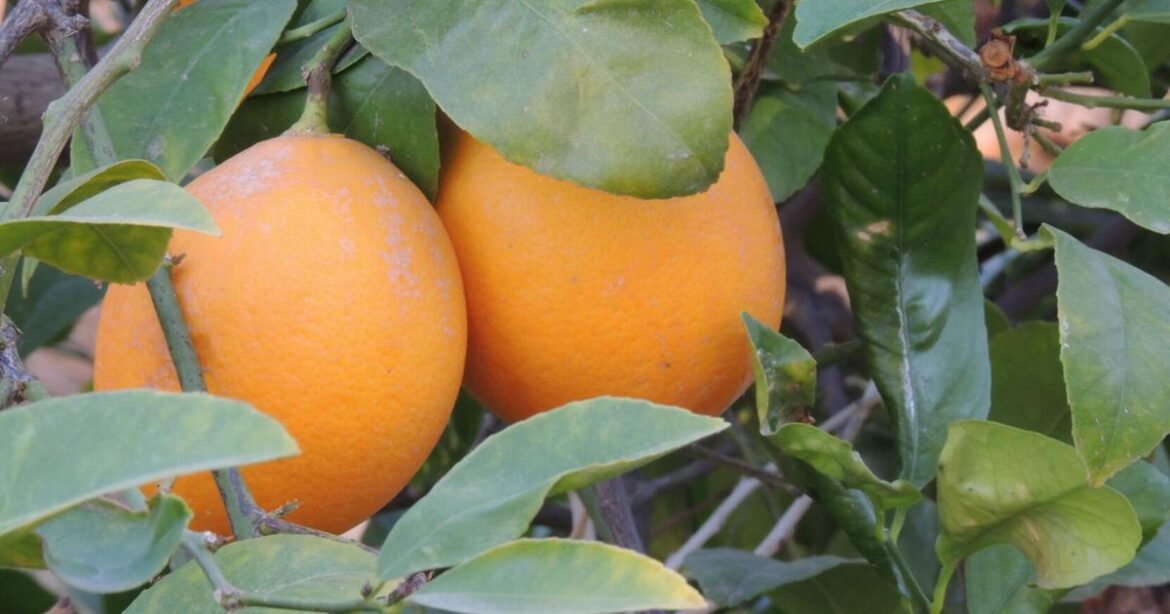Citrus sold in grocery stores are just a small fraction of the varieties that can be grown in your own yard. From grapefruit and tangelos to limes and kumquats, there is a myriad of varieties to choose from. Plant citrus after danger of frost has passed. Choosing a variety to plant is a matter of deciding which fruit you like best and the amount of space you have for a tree or two.
Although trees are small when planted, by maturity some varieties have canopies 20 feet wide and tall. Trees labeled semi-dwarf will grow about two-thirds the size of a standard tree. Choose a location in full sun, and plant trees at least ten feet apart.
A citrus tree does not need to be pruned unless it has overgrown its location. Citrus trees are actually large shrubs and should not have their lower branches removed since this exposes the trunk to sunlight that can sunburn the trunk and kill the tree. If your citrus tree has the lower branches removed, use a mixture of half white, water-based paint and half water to paint the trunk to protect it from the sun. Regular maintenance, done between February and March, includes removing any sprouts near the base of the trunk, diseased or broken branches, and deadwood.
Although hundreds of blossoms cover a tree in spring to attract pollinators, only about 2% become fruit. This is the tree’s natural way of thinning so that its branches do not break under the weight of its fruit. For best flavor, allow fruit to remain on the tree until fully ripened. Taste-test a piece of fruit to determine the right time to begin picking.
Weather conditions, amount of water, and correct fertilizing all affect fruit production and the length of time a tree produces fruit during the season.
“Use a balanced fertilizer on citrus trees,” said Dr. Glenn Wright, University of Arizona citrus specialist. “It can be 10-10-10 or 14-14-14, just so it has a balance of nitrogen, phosphorus and potassium. Fertilize citrus with one-third of their annual requirements three times annually in January/February, March/April, and May/June. A fertilizer chart giving amounts of fertilizer different citrus need can be found at https://extension.arizona.edu/publication/citrus-fertilization-chart-arizona.”
“As a general rule, citrus should be deeply watered once a month in winter and twice a month in summer. Enough water must be applied to reach the entire root zone,” said Dr. Wright. “A two-foot-long water meter can help a gardener learn how much water it takes to water 2-3 feet deep, which is what citrus require. To help retain water, construct a berm a foot past the edge of the tree’s canopy that is 4-8 inches tall to hold water.”
“As the tree grows larger, the basin should be moved away from the canopy’s edge to encourage its roots to continue spreading outward. Do not build a berm close to the trunk or bank soil around the trunk since this can cause the tree to die.”
There are a few problems to watch for when growing a citrus tree. If your tree has yellow leaves, it may have an iron or zinc deficiency which can be remedied with fertilizer. However, in winter, it is normal for some of the leaves to turn yellow and drop to the ground. If your fruit splits, this can be caused by irregular watering, sunburn, or low nitrogen.
Pests that harm citrus trees include whiteflies, red scale, mites, leaf miner insects, thrips and aphids. If necessary, a strong spray of water or an insecticidal soap spray will help control them.
If your tree has curled leaves with a grayish line, you have thrips feeding on the leaves. These tiny insects burrow inside the leaf bud and feed on new leaf growth. Although the leaves look deformed, they still photosynthesize, and the tree will still produce fruit.
A more serious problem is HLB (hulongbong) disease that has destroyed citrus orchards in South Texas, Mexico, California, Florida and Louisiana.
“If an Asian citrus psyllid insect is infected with HLB, when it feeds on a citrus tree, the disease enters the tree and blocks transport of nutrients through the tree, eventually killing it. Signs of HLB are yellow-blotched leaves and yellowish-green, small, misshapen fruit,” said Dr. Wright.
“The Asian citrus psyllid is a tiny, brown insect the size of a grain of rice that feeds with its rear end tilted in the air. Yellow sticky traps hanging from citrus trees in commercial orchards are checked to see if there are any psyllids. Contact UC Cooperative Extension for Imperial County at (442) 265-7700 if you think your citrus tree has psyllids.”
If you have room in your yard, consider planting a citrus tree that will produce fruit for many years to come.
May/June Gardening Activities
When hot weather returns, many gardeners solarize their soil during the summer to kill any unwanted weeds and pests. To solarize your garden, cover the soil with clear or black plastic and place lumber or bricks along the edges of the plastic to hold it down. Let the plastic remain for a month and then remove the plastic and turn the soil. Replace the plastic and solarize again.
The heat beneath the plastic kills unwanted weeds, grass, and critters without the need of pesticides or herbicides. At the end of August, remove the plastic, amend the soil and begin your fall garden. If you rely upon volunteer seeds in your soil for next season’s plants, do not solarize.
Vegetables to plant in May include yard long beans, black-eyed peas, Armenian cucumbers, cantaloupe, jicama, squash and okra.
Plant zinnia and sunflower seeds. Prune herbs if you do not want them to go to seed. Harvest garlic late in the month.

